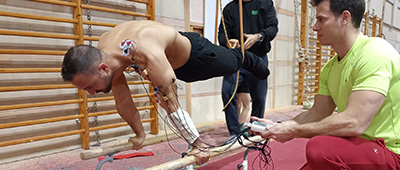312212 ‐ Muscle activity in different conditioning exercises for the front lever and full planche

Michel Marina & Priscila Torrado
We assessed muscle activity when doing the front lever and full-planche in different conditions habitually chosen to train the specific strength conditioning of these two gymnastic strength difficulties.
To fulfill this objective surface electromyography (sEMG) was used over the muscles considered as the main agonists. For the front lever we monitored the Latissimus Dorsi (LD), Teres Major (TM), posterior head of the Deltoid (DP), short head of Biceps Brachii (BB), long head of Triceps Brachii (TB), lower part of the Trapezius (TRLOW), the clavicular part of the Pectoralis Major (PMCL), and the abdominal head of the PM (PMABD). On the other hand, for the full planche we put sEMG electrodes over the anterior head of the Deltoid (DA), upper part of the Trapezius (TRUP), clavicular part of the Pectoralis Major (PMCL), short head of Biceps Brachii (BB), long head of Triceps Brachii (TB), extensor digitorum (ED), Flexor Superficialis Digitorum (FD) and Brachioradialis (BR).
Nine testing situations selected for the front lever: 1) Maximal isometric voluntary force (MVFISOM) in static shoulder extension on a methodological bench strength in supine position, 2) Static Shoulder extension in prone position on a balance beam, 3) Dragon Flag with hands gripped on the espalier wall bar, and front lever performed in four different situations like 4) High-bar 5) Rings under FIG requirements 6) Rings with one extended leg and the other flexed, 7) Rings with legs extended but abducted /separated. The front lever on the ring situation and FIG requisites was considered as the reference situation for normalization of the sEMG signal. The testing situations chosen for the full planche were: 1) MVFISOM in Handgrip, 2) MVFISOM of shoulder flexion in supine position, 3) MVFISOM Shoulder flexion in standing position, 4) Full planche in parallettes bars assisted with elastic band, 5) Planche on parallettes bars in tucked position, 6) Planche on parallettes bars in tucked position but one leg extended, 7) Open hip straddle on parallettes, 8) Open hip straddle on the rings.
The two last testing situations served to normalize the sEMG signal. MVFISOM was measured with a force gauge. In both studies body segment angles were supervised in order to be as similar as possible to the reference situation and according to FIG rules. Measurement of sEMG activity proved to be a useful method to quantify and discriminate the neuromuscular demand of different types of strength training exercises oriented to learn distinct types of strength gymnastics element on the rings.


